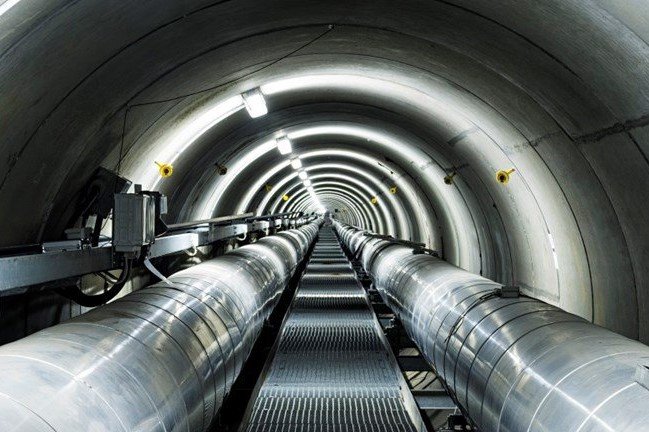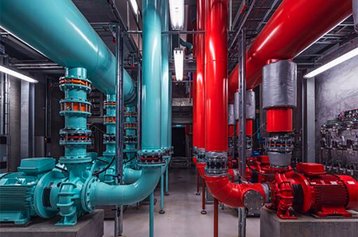Thermodynamics says that all energy will eventually become thermal energy. If you use 1kWh of electrical energy to run a computer, it will emit 1kWh of heat.
Astrid Wynne of TechBuyer explained it like this in a 2022 article: “The first law of thermodynamics, also known as the law of conservation of energy, states that energy can neither be created nor destroyed, but changes from one form to another. The electrical energy that data centers draw through the servers is almost entirely converted to heat. Data generation is a byproduct of this, but accounts for less than 0.1 percent of the conversion.”
To the data center engineer, that’s a problem, because that heat has to be removed or the equipment will overheat.
To the urban planner, that’s an opportunity. The community wants that heat.
Use your energy twice
Wynne says: “The term ‘data center’ is a misnomer in energy terms. It is more accurate to call them ‘heat centers’ which can also be used to process and store information. Flipping thinking in this way allows us to be more creative about how we plan and manage data center builds now and in the future.”
Communities need heat, and heating currently creates a lot of emissions. In the UK, for instance, heating makes up around 37 percent of total emissions. Some of that comes from high-temperature industrial heat, but more than half is simple space heating and hot water.
Right now, most of that heat is generated directly from fossil fuels, or else from electricity, much of which is also from fossil fuels.
To approach net-zero emissions, heating has to decarbonize, which is why governments are trying to phase out gas boilers, and look for alternative low-carbon heat sources. Electric ground source heat pumps are one such source, but they need to be powered by renewable energy.
Heat produced by computation is effectively zero-carbon, because it’s a byproduct of energy used elsewhere.
And if the heat is used elsewhere, it arguably cancels out the burden of the computation on the energy infrastructure. You get 1kWh of computing from 1kWh of energy that was going to become heat anyway.
There is, in theory, almost no limit to the demand for waste heat.
As Mark Bjornsgaard. CEO of Deep Green Energy, observed in a DCD podcast, the total requirement for building heating in Europe is vastly greater than the amount of energy used in data centers.
For instance, the UK uses around 434TWh of energy to make buildings warm each year. The total energy used in data centers is a tiny fraction of that, estimated at around 2-3TWh per year.
That’s 2-3TWh of heat produced each year in data centers. If that could all be used in heating then, on one level, those data centers would arguably have achieved net-zero in their operational energy use. And with more than 400TWh of heat still required, there’s scope to power the projected AI boom as well.
That’s a tantalizing prospect, but not so easy in practice - or is it?
The difficulty of heat networks
Data centers have been offering their waste heat for years. But very little is actually being successfully used.
Data centers offer a predictable supply of heat because they keep their servers running continuously. But the heat is “low-grade:” It is warm rather than hot, and it comes in the form of air, which is difficult to transport.
So, most data centers vent their heat to the atmosphere.
Sometimes, there are district heat networks, which provide warmth to local homes and businesses through a piped network. If your data center is near one of these, it is a matter of extending it to connect to the data center, and boosting the grade of heat.
But you have to be in the right place to connect to one. “There are certain countries that have established or developing heat networks, but the majority don't have a heat network per se, so it's going on a piecemeal basis,” Neal Kalita, senior director of power and energy at NTT, tells DCD.
You are unlikely to find one in the US, says Rolf Brink of cooling consultancy Promersion: “The United States is a fundamentally different ecosystem. But Europe is a lot more dense in terms of population, and there is more heat demand.”
The Nordic countries have a lot of heat networks. Stockholm Data Parks is a well-known example - a data center campus in urban Stockholm, where every data center has a connection to the district heating network and gets paid for its heat.
Germany has some heat networks, and plans to expand them. The UK has some, but experience has been difficult so far.
“I think the challenge with data centers plugging their heat into heat networks is when is that heat network going to be operational?” says Kalita.
How good is your heat?
Another big challenge is the quality of the heat: “It's not what we call high-quality heat or high-temperature heat,” says Kalita. “You can't run a whole heat network from one data center’s heat. You either need to install a heat pump and put more energy in to increase the temperature, or the heating network needs to have some kind of heat source.”
The heating network must be very close by, and the heat in the warm air has to be supplemented with other energy sources, such as burning biomass or using a heat pump to raise the temperature until it can be piped into the system.
In Sweden, for instance, computing expert Cloud&Heat has placed a data center consisting of two liquid-cooled 20-foot containers equipped with 1,600 high-performance graphics cards right at a combined heat and power (CHP) installation.
The CHP system burns biomass to make heat and electricity. The Cloud&Heat systems use some of that electricity, and their waste heat can go straight into the heat stream, so none is wasted.
Low-grade heat is less of a problem with newer “fourth generation” district heat systems, which have become better suited to handling lower-grade heat, through measures such as polythene pipes, which can hold the heat of warm water.
Bring in agriculture
Of course, homes in much of the world don’t need so much heat in the summer. The answer to that is planning, and finding other uses. Food production has a lot of processes that need heat, from greenhouses to fish farms, fermentation, and cheese production, Even in countries with warm summers, says Wynne, heat can still be used: “When the weather gets warmer, for example, the energy can be diverted from warming houses to fermentation sites.”
Green Mountain has been giving warm water from its data center in Norway to a fish farm, the underground Lefdal Mine elsewhere in Norway does the same, and the snow-cooled White Data Center in Japan uses its warmth to farm eels.
Valuing your heat
Another problem is that, because data centers see heat as a waste product, they don’t value it. Heat networks are a business, and they expect to buy heat on a commercial basis from a supplier committed to a predictable supply. They want a power purchase agreement (PPA) for heat.
“If you enter into a heat PPA, then the expectation is that you will provide that level of quality of heat and that volume of heat consistently,” says Kalita. “But there are occasions when data centers go down, or a customer leaves, or the facility needs to be refurbished, and then the heat falls away.
“Where you're committed to provide heat for 10 to 20 years, that can curb your flexibility.”
For some, that is not insurmountable. Heat reuse consultant David Gyulnazaryan told a London data center audience that waste heat is “a highly sustainable and reliable source of heat” and, if necessary, it can be “backed up by power generation in case of failure, which gives a 99.996 percent level of reliability.”
On the financial side, Gyulnazaryan says “the cost of converting low-grade heat from the data center is approximately €25/MWh, whereas the natural gas price is around €200/MWh.
The monetary saving potential is huge for public bodies, particularly when the natural gas supply is reducing.”
Brink says it’s a matter of planning: “When effectively considered during the build phase of a data center facility, heat can be a tremendous asset with fantastic reductions to your TCO.
“When choosing a location to build a data center, heat reuse is not factored in most of the time,” he says. “If you do factor it in, you could locate a data center next to a swimming pool, or in the vicinity of something that would have a use for the heat.”
He adds: “The discussion around heat reuse is a little bit out of balance simply because as long as it's not fed into the site scoping, it's going to be meaningless to discuss it later - simply because you're not selecting a site for for the purpose.”
Regulations promote heat sharing
The biggest problem with district heating systems could be that they take a massive investment and many years to implement. Some local and national governments are intervening to encourage the use of heat networks.
In the Amsterdam region of the Netherlands, data centers must be designed to be able to connect to district heat networks. Germany has similar rules across the whole country enshrined in its newly passed Energy Efficiency Act.
This has not been a simple matter: Earlier drafts of the bill required new facilities built from 2025 to reuse 30 percent of their heat. The German Datacenter Association objected, and the final act says data centers over 200kW need only to reuse 20 percent of their heat - and don’t have to do it till 2028.
The GDA still objects, as this requirement effectively limits data centers to locations where there are heating systems in place.
Benjamin Brake, head of the government’s Digital and Data Policy department at the Federal Ministry of Digital Affairs and Transport (BMDV), conceded to the GDA’s conference that: “The use of waste heat as the sole criteria for choosing a location is problematic, especially when there are no requirements and obligation for waste heat users.”
In the UK, there are around 14,000 mostly small heat networks, according to the National Housing Federation. The Fuel Poverty Action Group is critical of the state of Britain’s heat networks, arguing that domestic customers have few rights, since the networks are unregulated. They are also vulnerable to outages and steep price rises as most networks include heat input from natural gas whose price has shot up.
The Government has a pipeline of new district heating projects amounting to nearly £3 billion ($3.8bn). Only one project in Park Royal, with a £36 million ($45.4m) subsidy, intends to make use of data center waste heat. It won’t be switched on till 2040 (see box out).
Given the huge cost of the project, and its long time scale, many observers have expressed doubts to DCD that it will ever be completed.
“London absolutely hates roads being dug up,” says Kalita. “Imagine having to dig up the road for a new heat network across the distances that it will have to travel.”
Others have a more fundamental issue, and wonder whether it should be done at all.
“I am not close enough to the project to know, but when I saw the cost I did a double take,” says Charlie Beharrell of Heata. “The connection cost per home, excluding any IT or cost overruns, is more than the total cost of installing one of our systems.”
The systems he is talking about are variously called digital boilers and data furnaces.
Beharrell, along with Bjornsgaard and a coterie of other companies, are championing a different approach. It could be more effective than heat networks - but it rethinks the data center.
The data furnace
The idea of a data furnace was first proposed by Microsoft in a paper in 2011, authored by a group including Sean James. The basic idea is to put racks of servers in homes and offices where their heat is useful.
The development of the cloud means that useful jobs can be sent in encrypted form to the data furnace. Customers pay a price for the computing that covers the electricity used, and the host gets free heat.
“In the coldest climate, about 110 motherboards could keep a home as toasty as a conventional furnace does,” said the paper’s authors. “The rest of the year, the servers would still run, but the heat generated would be vented to the outside, as harmless as a clothes dryer’s.”
Various companies have developed businesses around the idea, including Qarnot in France and Cloud&Heat in Germany.
The latest generation of distributed heat and computing companies in the UK include Deep Green and Heata.
Deep Green puts compute-intensive servers in liquid-cooled immersion tanks, so their heat energy can be piped to nearby users. Its first customers are swimming pools. Heata offers heat appliances for domestic homes.
Both use the same cloud provider, Civo, to despatch jobs to their units,
The idea has the potential to outperform district heating networks, says Beharrell, because “it is much cheaper and easier to move the data than the heat.”
Data furnaces could be put in every dwelling in a housing development for instance, with only minimal infrastructure needs. The homes already have power.
Some might need network upgrades, but that is a much smaller job than laying pipes from a large data center building, via the heating system, to each house.
Beharrell doesn’t think the two approaches are at odds, he is happy to see projects like the Park Royal heat network go ahead: “I think it's good to be optimistic, and honestly, it is good for everyone if it goes ahead.”
But he’d like to see more awareness of the possibility of actually distributing computing, rather than moving heat: “It would be nice to see greater investment behind more disruptive models rather than reinforcing the status quo.”
Deciding which approach is best for a given situation requires genuinely strategic thinking,
“Achieving the carbon reductions necessary by 2050 means a whole systems approach,” says Wynn. “Integrating data centers into this would go a long way towards achieving success.”








